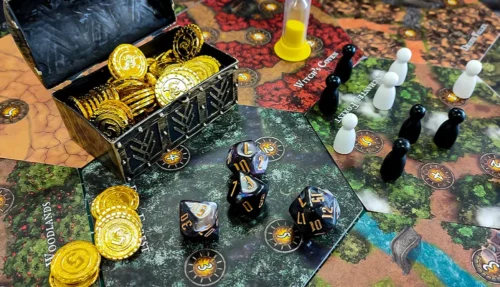New to board game design? Based on over 25 years working with independent creatives, we share the fundamentals of successful board game design, so you can get off to a great start!

Introduction
Board games are a great way to express yourself creatively and share fun times with friends and family. You can also design your own, get them printed, published, and build a following for pleasure or profit. However, designing a successful board game is not easy. It takes time, patience, and talent. But if you follow these basic steps, your game will be one that everyone wants to play over and over again. Let’s dive into the fundamentals of board game design.
Getting an idea
You may already have an idea for a game, or you may not. Either way, it’s important to start with a strong conceptual foundation. There are so many different kinds of game on the market that it can be a tough call honing down your idea. But if you want to design a board game to sell, while it must be original, it should also fit into a clear genre category so potential buyers can quickly understand what to expect. The following questions can help you identify what kind of game you want to develop:
- What do I want the players to experience in this game? Is it a strategy game? A chase or race game? Is it a collecting game? Cooperative or competetive? How many players can join in? Will a game last half an hour or several hours, or even days?
- Who will play it and how often? Is it for children or adults? Maybe it’s for the whole family? Is it for fans of fantasy, science fiction, mystery stories, math puzzles, or some other group?
- How much time am I willing to invest in developing it (and how much money)? Developing a board game can take weeks or months, or even years and can cost very little to several thousand bucks. How much time and money you have to invest will decide on the style and complexity of a game that you can successfully create.
If you were starting from scratch and had no prior knowledge of board games or their design, these are all valid questions that would need answering before you could begin working on any game design project.

Developing the theme
Theme is vital to any successful game. It’s what gives it its imaginative context and central idea. You need to choose a theme that is interesting to you and that you can be passionate about so that your enthusiasm will carry across to the players and sustain you through the long—and sometimes frustrating—hours, days, and months of development work. You also want to make sure that the theme is clear and easy for players to understand, so they can get into the game quickly without having any confusion about what they are doing or why.
The theme should be appropriate for the type of game design you are creating — if it’s too broad or too narrow, then there might not be enough content in the game for players who want more depth; likewise, if it’s too complicated (or just plain boring), then players won’t enjoy playing it as much either!
Working out the mechanics
Once you have a general idea of the genre of game, the theme, and the core objective, let’s look at the different types of mechanics you might employ and how they work.
Mechanics are the actions and interactions in a game. They can be as simple as moving pieces around on a board or rolling dice, or more complicated like taking turns in an order determined by cards played from your hand. The most common mechanic is rolling dice: when someone rolls their dice, they’re using one type of mechanic — but there are many others! There are also card games where players draw cards from their hands (like Poker), games where players have individual decks with unique abilities (like Hearthstone), cooperative games where everyone works together against an opposing force (like Pandemic), competitive games where players compete against each other directly (think chess).
You’ll need to figure out what type(s) of mechanic(s) will work best for your idea before getting started with designing anything else.
Choosing components

Game components are all the physical aspects of your game, such as the board, figures, dice, spinners, coins, cards, tokens, and so on. The components you choose for your game are crucial to its success. They are the physical manifestation of your ideas, and they must work seamlessly with the mechanics of your game. The following questions should help guide you in choosing the right components:
- Is this component appropriate for my theme? If not, why am I using it?
- Does this component work well with my game’s mechanics? If not, what can I do about it (or should I just switch out this component altogether)?
- How easy is it going to be for me or my manufacturer(s) to produce these pieces at scale — and will mass production drive up costs too much?
Playtesting and revising your game
Playtesting and revising your game design is probably the most fundamental of all the aspects of successful board game design.
The most important part of the process is playtesting. Playtesting allows you to see how your game works in practice, as opposed to theory. You should try out as many people as possible, especially those who don’t know anything about board games but have played them before (they’ll be able to give you a more honest and objective perspective). If anyone has any questions or suggestions for improvement, write them down so that later on when revising your game design, those questions can be addressed directly and made into actual changes within the rule set itself.
If after several rounds of playtesting someone isn’t having fun with it, then maybe consider revising some things. There are many ways this could happen: maybe there aren’t enough choices available at any given time; maybe there’s too much randomness involved which makes things less strategic; maybe there aren’t enough opportunities for players’ actions during their turn.
Be ready to playtest, revise, and reiterate a lot. Just as professional novelists edit and revise their books several times before they’re ready for publication, so board game designers need to go through a similar process.

Make prototypes of your game design
A prototype is a sample or model of something. It can be made from paper, cardboard and plastic. The purpose of prototypes is to test the game mechanics and theme of your board game designs before you start making production copies of your board game design. Your first prototypes will probably be made by hand using substitute materials such as card and paper and items borrowed from other, old games as “stand ins”. Only once your game is close to completion should you spend money on professional samples and prototypes.
Finalize and refine your game design.
- Finalize the rules. Is there anything unclear? Can they be shortened or simplified? Are there any places where player confusion might occur (or worse)? Make sure everything works as intended before sharing it publicly!
- Finalize components and artwork. How much does this cost? What are my options for manufacturing quality components at different price points? Will your artist be able to create all of your desired art assets within budget constraints?
- When choosing a company to handle manufacturing services like offset printing or component manufacture, consider whether their work meets the standards you expect, their experience in the field, how competitive are their prices, and whether they have high standards of quality and customer service.
Ready to play? Let's talk!
When you’re ready to print your board game and manufacture your components, talk to us. We’ve got over 25 years’ experience in the industry, helping independent creatives just like you to realize their dreams. It’s free to talk and when you’re ready we’ll give you a no-obligation quote on the work, so that you know upfront exactly what’s involved. We can’t wait to work with you!











